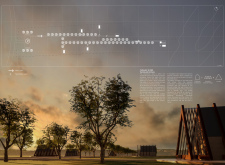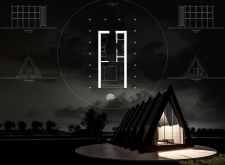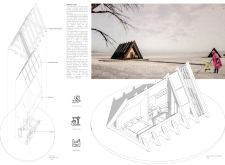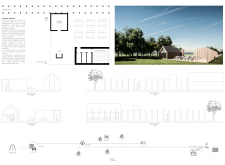5 key facts about this project
The Caramel Shore Traveller Rooms project is located in Skrunda, Latvia, between a public road and the Venta River. The design connects the built environment with the natural landscape, providing a mix of tourist accommodations and shared spaces. The overall concept emphasizes modern interpretations of local architecture, creating a welcoming atmosphere for visitors while ensuring functionality.
Architectural Configuration
The site is laid out in an elongated form, facilitating a promenade that leads to the river. This design promotes easy access and encourages interaction with the environment. At the entrance, parking areas are arranged to maintain the privacy of the tourist units, illustrating a thoughtful approach to site circulation and user experience.
Tourist Units
Five tourist units are positioned centrally, reachable via landscaped, tree-lined paths. Their triangular shapes reflect aspects of local rural architecture and reinforce ties to regional identity. Each unit rests on a circular concrete base, offering stability and contributing to the overall aesthetic that blends with the natural surroundings.
Interior Design
Each unit spans about 19.95 square meters and is designed for efficient use of space. The layout includes a kitchenette, dining area, bathroom, and raised bedroom. This arrangement creates a harmonious flow and maximizes functionality. Large frameless windows on the rear walls allow natural light to fill the interiors and provide views of the landscape, enhancing the connection between indoor and outdoor spaces.
Materiality
The project emphasizes sustainability in its material choices. Wood features prominently in the structure, aligning with local building practices. The curtain walls utilize prefabricated multilayer wooden panels, which streamline construction and improve insulation. This choice contributes to thermal comfort for guests, enabling a pleasant stay throughout various seasons.
The Caramel Shore Traveller Rooms exemplifies how thoughtful design can form a strong relationship with the surrounding environment. The careful crafting of each unit and communal area provides visitors with a space that invites engagement with nature, all while respecting local architectural traditions.






















































